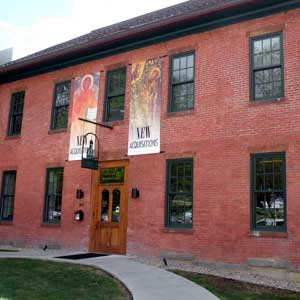The Museum of Russian Icons was founded in 2006 by Gordon B. Lankton, industrialist and co-founder of the plastics company Nypro. Lankton’s collection houses over 500 icons and artifacts, which makes it the largest icon collection in North America. It’s also one of the largest private collections of its kind outside of Russia, with icons dating from the age of Andrei Rublev in the 1400’s down through to the present. In 2011 Lankton acquired the ‘St. Nicholas of Zaraisk’ icon, which dates back to 1550. It’s size is monumental, stretching 52 inches by 40 inches. Another impressive acquisition was the “Christ in Majesty” icon, purchased in 2009. This icon is 49 inches wide and 65 inches high. Both icons hung in Sir Richard Temple’s gallery in London before coming to Massachusetts.
Since its founding the massive icon collection has attracted a lot of attention from the press, the public and the international community. One of a few interesting blurbs on the museum’s website is a quote from Andrey Busygin, Deputy Minister of Culture of the Russian Federation. He said this of the museum: “A real oasis of Russian culture in a small city in Northern America! Thank you! You make Russian-American cultural relations more deep and stable.” And indeed, the mission statement of the museum is to “enhance relations between Russia and the United States through the medium of art, especially Russian icons.”
Since the collapse of the Soviet Union, the collection of icons has grown more diplomatically-problematic because of legal constraints on the removal of ancient icons from Russia. This is in sharp contrast to the situation under Soviet rule. Icons were at one time being destroyed or sold off as a matter of course by the Soviet government in order to purge the country all religious remnants.
It was Lankton’s frequent business trips to the Soviet Union in the 1980s and 90s which created and fed his interest in Orthodox icons. He began collecting in 1989 and eventually amassed a collection so large it demanded public attention. At the inception, Lankton conceived of the Museum of Russian Icons as primarily a nonprofit educational institution. The museum today retains this focus on cultural, artistic and religious exchange. It is frequently host to expert speakers and musical performances. It even holds art workshops and icon painting classes. This focus on teaching extends even to the museum’s website, which includes information on the history and technical production of icons. The full catalog of icons is also available for viewing, with advanced search features for ease of inquiry.
The museum is housed in a converted system of historical buildings first erected 150 years ago. Now visitors can see 15th century Russia icons within a mill, courthouse, and police station from civil-war-era New England. It makes for quite a unique experience of history. While the buildings have mostly retained their external facades in order to properly compliment the adjoining public common, Central Park, the interiors have been completely revamped in order to better protect and showcase the impressive collection of icons. This includes extensive insulation for temperature and humidity control as well as the addition of tea room, a terrace and a concert/lecture hall. A brand-new addition was built onto the mill building in 2008 in a contemporary architectural style, marked by its use of aluminum. This was done for additional gallery space, but also to house a library and museum offices.
The rear view of the mill offers a very contemporary face and actually features an LED light show when it gets dark.
Source Material From:
“Museum Acquires 1550 Icon” – Telegram and Gazette – 9/2/11
“Clinton Museum Celebrates Acquisition of Massive Icon” – Telegram and Gazette – 6/19/09
“Collector Shares His Love of Russian Icons” – Boston Globe – 2/10/08







